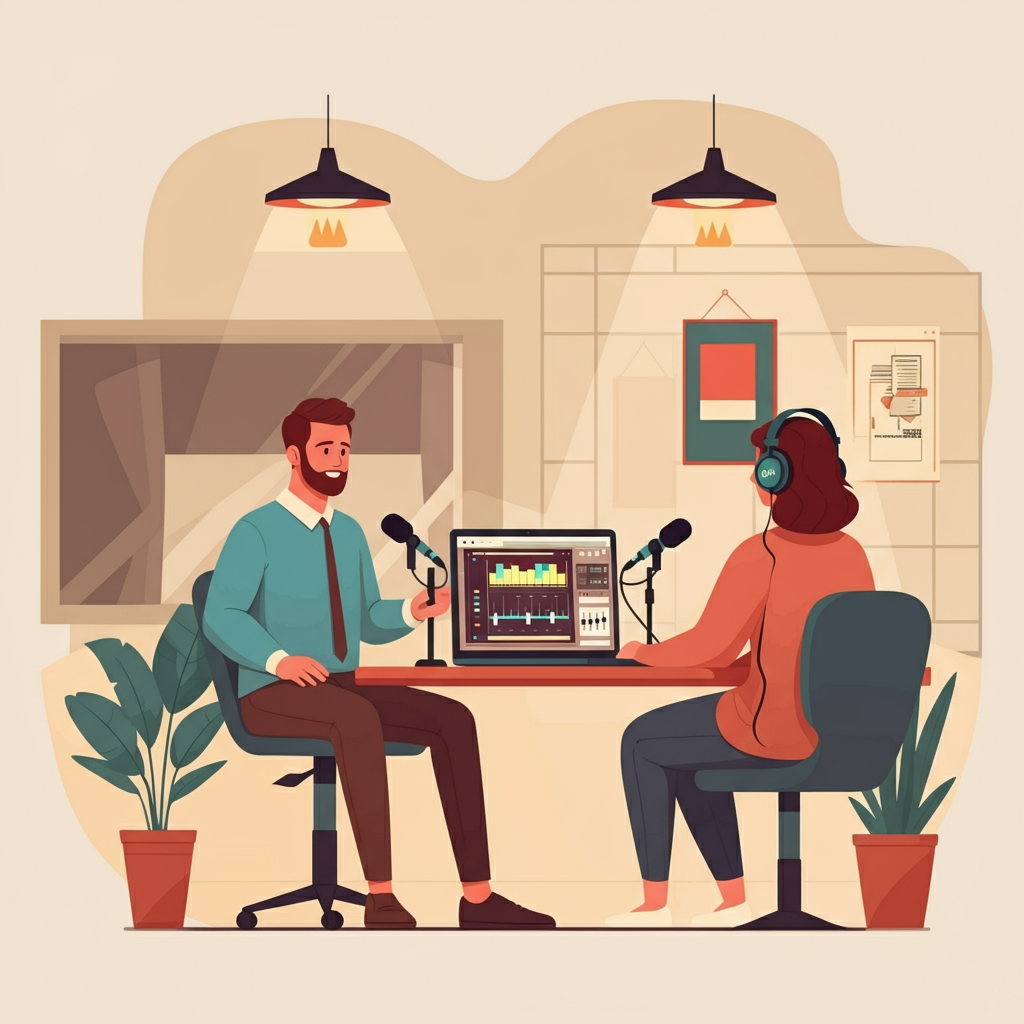Technology
|
4 July 2025
How To Play Audio Clip For Guests In Podcast | Expert Tips
Written by Faizan
Full Stack Developer
Discover how to play podcast audio clips effectively. This FAQ covers legal tips, tools, and seamless integration for an engaging listening experience.

Table of Contents
Playing audio clips during a podcast can elevate your content by adding depth, context, and entertainment to conversations. It allows hosts to reference moments from other media, include guest contributions, or introduce sound effects for a more polished production.
However, seamlessly integrating audio clips into your podcast requires proper tools, preparation, and know-how. This blog will walk you through the importance of playing audio clips, discuss the tools you can use, and provide step-by-step instructions to make it happen effortlessly.
Why Playing Audio Clips in Podcasts Matters
Including audio clips in podcasts serves multiple purposes. Here are a few reasons why podcasters often use them:
- Enhance Listener Engagement: By breaking up a standard dialogue with a soundbite, podcast hosts can re-capture the audience’s attention.
- Support Key Points: Clips can reinforce a discussion point or offer evidence in a debate.
- Add Professionalism: Podcasts featuring audio samples or music sound more polished and professional.
- Context Building: When discussing a specific media piece, playing the clip makes the topic clearer for your listeners.
Whether you’re including a soundbite from a news story or a funny anecdote recorded earlier, incorporating these elements can differentiate an average podcast from an exceptional one.
Essential Tools for Playing Audio Clips in Podcasts

To play audio clips effectively during your recording sessions, you'll need the right tools. These range from virtual mixers to podcasting platforms designed for media integration.
1. Virtual Audio Mixers
A virtual audio mixer is ideal for managing and integrating playback audio during your podcast. Tools like VB Audio VoiceMeeter allow you to route system sounds, voice input, and audio clips into one stream seamlessly. This way, guests and hosts hear the audio simultaneously, ensuring discussions flow naturally.
How to Use It:
- Install the virtual mixer on your computer.
- Configure your input sources (e.g., microphone, audio clips) and output to your recording platform.
- Test the playback before your live session to avoid hiccups.
For those unsure how to get started, Voice Meeter offers user guides and video tutorials for detailed guidance.
2. Podcasting Platforms
Platforms like Squad cast and Riverside.fm go beyond standard audio recording. They include features allowing you to play audio clips for guests in real time, ensuring professional quality and reduced latency.
- Squad cast is simple and reliable, offering separate tracks for clearer post-production.
- Riverside.fm allows automatic local recording for all users while playing external audio clips via shared soundboards.
These platforms are excellent for remote podcasting setups.
3. Audio Editing Software
If you don’t want to play clips live during your podcast, preparing clips ahead of time using software like Audacity can ensure smooth transitions during editing. Audacity is free, user-friendly software for trimming and enhancing audio quality.
Quick Tips for Using Audacity to Prepare Clips:
- Import the audio file to edit.
- Use the selection tool to highlight the segment you need.
- Export the trimmed clip as a high-quality MP3 or WAV file for use during the podcast.
For a more detailed guide on tools, check out this article on podcast audio tools.
4. Soundboards & Playback Apps
Soundboard apps like Sound byte or extensions like Jingle Palette allow you to preload specific audio files and play them with a click. These apps are perfect for real-time podcast recordings since they prevent errors like dead air or lost files.
Pro Tip: Use hotkeys to speed up clip access during live recordings.
Step-By-Step Guide to Playing Audio Clips During Podcasts
Below is a step-by-step process to ensure you’re prepared to incorporate clips without disruptions.
Step 1: Prepare the Audio in Advance
Before recording, gather the audio files you plan to use. Trim them to the required length using software like Audacity. Ideally, save the files in universally compatible formats like MP3.
Step 2: Choose the Right Tool
Decide whether you’ll use a virtual mixer, soundboard, or built-in podcasting platform features. Virtual audio mixers are best for more complex setups, while soundboards and software integrations work well for streamlined use.
Step 3: Pre-Test Your Setup
Always test your setup ahead of time. Play the clip to check for volume balance, clipping issues, or system compatibility. If using a platform like Squadcast, ensure your guest hears the clip clearly.
Step 4: Communicate with Guests
Brief your guest on when and how you’ll include audio clips. This avoids surprising them mid-discussion and ensures their reactions stay on point.
Step 5: Monitor the Playback During Recording
Live monitoring ensures the clip plays correctly without interruptions. Use headphones to avoid creating feedback loops, and keep tabs on volume levels for consistency.
Step 6: Edit for Seamless Integration (Optional)
If you choose to add clips in post-production instead of live, edit your recording to ensure smooth transitions. Tools like Audacity or paid options like Adobe Audition make this step easy.
If you’re new to audio editing, this guide on How to Export Audio in Waveform (WAV) contains helpful tips.
Tips to Optimise Podcast Audio with Guests

Playing audio clips is just one part of a great podcast. Pairing it with a robust guest audio setup ensures the best listener experience. Here are additional tips for optimising guest audio quality:
Use Headphones for All Participants
This prevents feedback issues and maintains sound clarity during recordings.
Invest in Microphones
Encourage guests to use a high-quality USB microphone, such as the Blue Yeti, for crisp recordings. If budget permits, send affordable equipment to frequent contributors.
Minimise Background Noise
Ask your guest to record in a quiet, echo-free room. Turn off all notifications to avoid interruptions.
Enable Separate Audio Tracks
Platforms like Squad cast enable separate audio streams for each participant, smoothing out the editing process.
Test Internet Connectivity
A stable internet connection reduces lag and ensures clips are played in sync.
Keep Guests Comfortable
Share your recording procedure beforehand to demystify the process. Providing details like time stamps for clips allows them to prepare for discussions ahead of time.
For additional insight into guest setup, explore this handy guide to podcast guest audio setup.
Wrapping Up
Playing audio clips in your podcast is easier than it might seem, provided you have the right tools and follow a detailed process. Platforms such as Squad cast, virtual mixers like Voice Meter, and editing software like Audacity make integration smooth and professional. Pairing this strategy with solid guest audio preparation will create a polished, engaging experience for your listeners.
Start incorporating clips into your podcasts today to improve listener engagement and make your show stand out in the competitive world of podcasting!
Podcast Audio Clips FAQ
1. Why should I use audio clips in my podcast?
Audio clips can enhance your podcast by adding variety and keeping listeners engaged. They help illustrate points, evoke emotions, and break the monotony of speech.
Clips like music or sound effects can set the mood, while interviews or historical recordings add depth and credibility.
2. What types of audio clips can I include?
You can use a variety of audio clips, such as:
- Sound effects for atmosphere or transitions.
- Music to set the tone or create an intro/outro.
- Guest excerpts from interviews for emphasis.
- Archival footage or public domain recordings for historical context.
- News snippets to align discussions with real-world events.
3. How do I legally use audio clips?
To use audio clips legally, you must ensure you have the right permissions. Options include:
- Licensing audio from creators or platforms like royalty-free libraries.
- Using audio under a Creative Commons licence that allows redistribution.
- Creating or sourcing public domain content.
- Incorporating your own original recordings. Remember, even a few seconds of copyrighted material can require permission.
4. What tools or software can I use to play audio clips during a podcast?
There are several tools available based on your needs:
- Dedicated soundboards like Soundplant or Jingle Palette allow easy playback of preloaded clips.
- Podcast software like Audacity, GarageBand, or Adobe Audition lets you incorporate clips during post-production.
- Live recording software like Zencastr, Riverside.fm, or OBS Studio supports real-time integration of clips during a recording session.
5. How can I ensure the audio quality of the clips?
To maintain high quality:
- Use clips recorded or exported in high bitrate formats, such as WAV or 320kbps MP3.
- Avoid using overly compressed or low-quality files.
- Edit and normalise the clips with audio editing software to match your podcast's audio levels.
- Test clips before recording to prevent distortions or interruptions during playback.
6. Can I use live audio clips during a recording?
Yes, you can use live audio clips during a recording. This is typically done with tools like a soundboard or multi-track recording software. Live clips can add immediacy and spontaneity, but ensure you rehearse and test them to avoid technical errors.
7. How do I integrate audio clips seamlessly into my podcast?
Seamless integration requires preparation and skill.
- Plan their timing to avoid interruptions or awkward pauses.
- Use crossfades or transitions to blend clips naturally with your speech.
- Match the clip volume with your speaking volume to maintain consistency.
- Practiseusage of clips during rehearsal if recording live.
- If editing post-production, ensure the alignment and pacing enhance the listening experience.
By integrating clips thoughtfully, you can elevate your podcast, making it more dynamic and professional.
Revolutionize Your Workflow with Transcripter
Ready to streamline your content creation?
